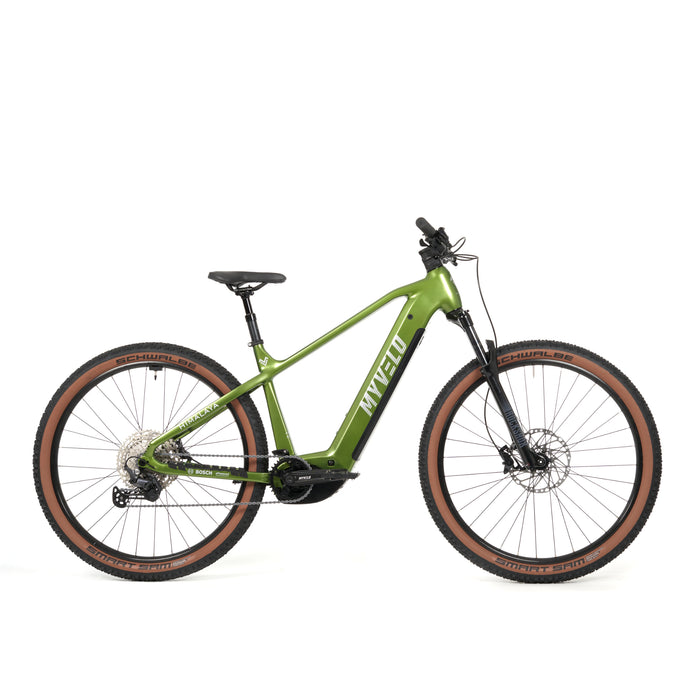
Himalaya E-MTB
incl. FREE shipping & free returns
📣 Only for a short time 200€ savings
📦 Delivery end of August

An e-bike controller is the electronic heart of an e-bike. It controls and coordinates communication between the motor, battery, display, and sensors (e.g., pedal force sensor, speed sensor). Without it, the interaction of these components would not function.
Engine control:
The controller regulates how much power is transferred from the battery to the motor – depending on your pedaling power, speed and selected support mode.
Sensor evaluation:
It processes the signals from pedal force, torque or speed sensors and decides how much support the motor should provide.
Energy flow management:
It ensures that the battery is used efficiently and prevents overload, overheating or deep discharge.
Communication with the display:
The controller transmits information such as speed, battery level, support level or error codes to the display.
Security features:
In case of malfunctions (e.g. defective sensor, overcurrent, overheating), the controller switches off the motor partially or completely to prevent damage.
Depending on the e-bike model, it can be located:
in the motor housing (often in mid- and hub motors),
in the battery case or
in a separate control box on the frame.
The controller is generally not universally interchangeable – it must be precisely matched to the motor, battery, and sensors. Therefore, in the event of a defect, a compatible replacement from the same manufacturer is often necessary (e.g., Bosch, Shimano, Bafang, DJI).
The e-bike controller is the "brain" of the e-bike — without it, there would be no controlled assistance. It ensures a safe, efficient, and smooth riding experience.

Entdecke den MYVELO
Entdecke Dein Traum E-Bike im MYVELO Onlineshop. Direkt vom Hersteller Dein Fahrrad aussuchen.

Dein Traumrad
MYVELO hat bereits 2 Standorte: Oberkirch & Geretsried. Komm in unsere Flagship Stores und probiere Dein Traum Bike aus. Lass Dich von uns zu Deinen Anforderungen beraten.

Leasen statt kaufen
Spare mit Leasing! Finanziere Dein Traum E-Bike ganz einfach über Deinen Arbeitgeber. MYVELO unterstützt Dich im Leasing-Prozess bei Deinen Fragen.

Wer sich den Traum vom hochwertigen E-Bike erfüllen möchte, steht oft vor einer großen Investition. Doch immer mehr Menschen entdecken eine clevere Alternative zum Kauf: das Fahrrad privat leasen. Was bisher vor allem im Jobrad-Modell über Arbeitgeber bekannt war, funktioniert heute auch für Privatpersonen – flexibel, günstig und steuerlich oft vorteilhaft.

Wer mit dem Fahrrad oder E-Bike unterwegs ist, weiß: Die richtige Schalttechnik macht den Unterschied zwischen einem flüssigen, energiesparenden Fahrstil und unnötiger Anstrengung. Doch viele Radfahrerinnen und Radfahrer nutzen ihre Gangschaltung nicht optimal – sei es aus Unsicherheit oder Gewohnheit. In diesem Artikel erfährst Du, wie man richtig schaltet, worauf man bei E-Bikes mit Kettenschaltung oder Nabenschaltung achten sollte und welche Fehler man vermeiden kann.

Das Hollandrad ist längst mehr als nur ein Klassiker aus den Grachtenstädten der Niederlande – es ist ein Sinnbild für entspanntes Radfahren, Komfort und zeitloses Design. In deutschen Städten erlebt das Hollandrad derzeit ein echtes Comeback, nicht zuletzt, weil es den urbanen Lifestyle perfekt widerspiegelt. Doch worin unterscheidet sich ein Hollandrad eigentlich von einem Citybike – und welche Rolle spielen moderne E-Bike-Versionen?